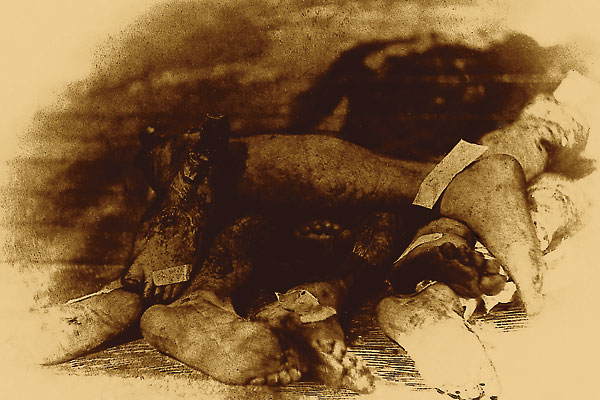
Let’s revisit those beginning scenes in Dances With Wolves, when Lt. Dunbar (Kevin Costner) is lying, bootless, with an injured right foot in the surgical tent awaiting medical attention.
Upon his arrival, rather than starting treatment, the two exhausted surgeons, or “sawbones,” decided to take a coffee break, giving Dunbar a short time to examine his surroundings. He saw filthy instruments and metal pans full of blood and gore. He focused upon the pile of boots near his gurney. Using a wooden cane, he retrieved a usable boot. He tried to pull it over his injured foot; but he was unable to bear the pain. He broke the cane in two and while biting down on the broken half, suffering agony beyond description, he pulled the boot over his injured foot and left the surgical tent to pursue a suicidal quest that turned him into a hero.
The name “sawbones,” often applied to a military surgeon or frontier doc, was correctly derived. In that horrible tent behind battle lines, men arrived with gunshot wounds, saber or knife lacerations, blunt trauma, avulsion (tearing) or crush injuries, infections and partial or complete amputations. Lacking time, with limited options, battlefield surgeons often treated severe extremity injuries or infections with amputation, a procedure usually requiring the sawing of bone.
Reader Amelia Metz, from Durango, Colorado, wants to know the gruesome details of this grisly surgery; so this month I will describe just how this procedure was performed.
Consider an alternative screenplay in which the exhausted surgeons discovered the mess tent had run out of coffee. Both men, therefore, returned their attention to Lt. Dunbar. These docs did not have the time to offer proper medical care to the lieutenant, who was one of many other soldiers with serious injuries. After examining Dunbar’s mangled foot, both docs decided upon amputation. The question was whether to saw off his whole foot or only part of it.
Let’s assume the injured foot sustained significant tissue damage, with vascular compromise (poor blood flow) and nerve injury just distal (farther down the foot) to the metatarsal bones (those bones just below the ankle joint that are analogous to the long bones of the hand, distal to the wrist joints). In the trauma surgeon’s mind, absent amputation, Dunbar’s injury was a perfect setup for the development of gangrene that could lead to the lieutenant’s death from blood poisoning.
Under ideal circumstances, the surgical objective would be to remove as little of the foot as possible, leaving healthy tissue, adequate skin flaps and a surgical stump upon which the amputee could remain relatively mobile and comfortable. A partial foot amputation, however, would be a more complicated and time-consuming procedure than simply amputating the foot above the ankle. These sawbones had no time (or probably skill) to risk the complexity of amputation involving the metatarsal bones. In 1887’s Manual of Operative Surgery, Dr. Joseph D. Bryant described a partial foot amputation through the complex anatomy of ligaments (tie bone to bone), tendons (tie muscle to bone), nerves, bones and blood vessels. Dr. Bryant indicated, “Over twelve percent are reported to have died from the operation alone.”
Our “sawbones” would probably have proceeded with an amputation of the entire foot above the ankle. Dr. Bryant reported, “This may be considered one of the most practical of the operations on the foot and ankle. It is followed not only by a low rate of mortality, but also by a most serviceable stump, either with or without an artificial appliance.”
In our alternative screenplay, Lt. Dunbar would have lost his entire right foot. Within minutes, it would have been thrown onto the gruesome heap of other amputated body parts piled nearby, waiting to be buried or burned.
Dunbar still would have survived his ordeal, but his next destination would not have been out west to Fort Hays, Kansas. In those unforgiving days, he probably would have been sent home to cope as a cripple without the services of an orthotist (an artificial limb maker), a physical therapist or a vocational specialist to help him train for a new job.






